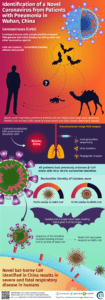The 2019 novel coronavirus (CoV) causes fatal pneumonia that has claimed over 1300 lives, with more than 52000 confirmed cases of infection by February 13, 2020, all in the span of just over a month. But, what is this virus? Is it a new virus altogether? Where did it come from? Scientists from top research institutes in China teamed up to answer these questions, and results were published in Chinese Medical Journal.
In early December, a few people in the city of Wuhan in the Hubei province of China became sick after going to a local seafood market. They experienced symptoms like cough, fever, and shortness of breath, and even complications related to acute respiratory distress syndrome (ARDS). The immediate diagnosis was pneumonia, but the exact cause was unexplained. At the time the major question was what caused the viral pneumonia infection? Was it is due to severe acute respiratory syndrome (SARS)-CoV? Or the Middle East respiratory syndrome (MERS)-CoV?
Collaborative research by scientist from China and Japan, jointly discovered and identified the new CoV [nCoV]—the main culprit of the Wuhan outbreak—by next generation sequencing (NGS). They focused on five patients admitted to Jin Yin-tan Hospital in Wuhan, most of whom were workers in the Huanan Seafood Market in Wuhan. Some patients’ condition rapidly worsened to Acute respitory distress syndrome (ARDS); one even died. Dr Wang says, “Chest x-rays of the patients showed some hazy opacities and consolidations, which are typical of pneumonia. However, we wanted to find out what caused the pneumonia, and our subsequent experiments revealed the exact cause—a new CoV that was not known before.”
For the study, the scientists used bronchoalveolar lavage (BAL) fluid samples taken from the patients. Based on sequencing of the DNA/RNA from the BAL fluid samples, the scientists found that most of the viral reads belonged to the CoV family. Viral sequences were 99.8-99.9% similar among all the patients’ samples, confirming that this virus was the common pathogen in all the patients. Further, using homology analysis they confirmed that the viral genome sequence of this new virus is 79.0% similar to the SARS-CoV, about 51.8% similar to the MERS-CoV, and about 87.6–87.7% similar to other SARS-like CoVs from Chinese horseshoe bats (called ZC45 and ZXC21). Phylogenetic analysis showed that the sequences of the five CoV strains obtained were closest to those of bat-derived strains, but formed separate evolutionary branches. These findings clearly suggest that the virus originated from bats. Dr Wang states, “Because the similarities of the viral replicase gene with all other known “similar” viruses are still less than 90%, and also taking into account the phylogenetic analysis results, we consider that this is indeed a new, previously unknown CoV. This new virus is temporarily called the 2019-nCoV.”
Although 4 of the 5 patients from whom this virus was identified were from a seafood market in Wuhan, the exact origin of infection is unknown. The CoV could have been transmitted to humans through an “intermediate” carrier, such as in the case of SARS-CoV (palm civet meat) or MERS-CoV (camel). Dr Wang concludes, “All human CoVs are zoonotic, and several human CoVs have originated from bats, including the SARS- and MERS-CoVs. Our study clearly shows the urgent need for regular monitoring of the transmission of bat-origin CoVs to humans. The emergence of this virus is a massive threat to public health, and therefore, it is of critical importance to understand the source of this virus and decide the next steps before we witness a larger scale outbreak.”
Journal Article: Ren et al., 2020. Identification of a novel coronavirus causing severe pneumonia in human: a descriptive study. Chinese Medical Journal
Summary provided by Indrani Das
Media Contact: Peifang Wei












